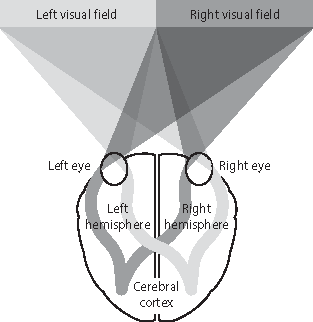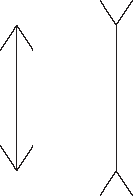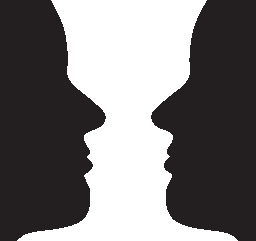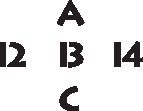Example: People can often see a star in the night sky if they look a little to the side of the star instead of directly at it. Looking to the side utilizes peripheral vision and makes the image of the star fall onto the periphery of the retina, which contains most of the rods.
Cones are cone-shaped cells that can distinguish between different wavelengths of light, allowing people to see in color. Cones don’t work well in dim light, however, which is why people have trouble distinguishing colors at night. The fovea has only cones, but as the distance from the fovea increases, the number of cones decreases.
| Feature | Rods | Cones |
| Shape | Long and narrow | Cone-shaped |
| Sensitivity to light | High: help people to see in dim light | Low: help people to see in bright light |
| Help color vision | No | Yes |
| Present in fovea | No | Yes |
| Abundant in periphery of retina | Yes | No |
| Allow peripheral vision | Yes | No |
Adaptation to Light
Dark adaptation is the process by which receptor cells sensitize to light, allowing clearer vision in dim light. Light adaptation is the process by which receptor cells desensitize to light, allowing clearer vision in bright light.
Connection to the Optic Nerve
Rods and cones connect via synapses to bipolar neurons, which then connect to other neurons called ganglion cells. The axons of all the ganglion cells in the retina come together to make up the optic nerve. The optic nerve connects to the eye at a spot in the retina called the optic disk. The optic disk is also called the blind spot because it has no rods or cones. Any image that falls on the blind spot disappears from view.
Transmission of Visual Information
Visual information travels from the eye to the brain as follows:
- Light reflected from an object hits the retina’s rods and cones.
- Rods and cones send neural signals to the bipolar cells.
- Bipolar cells send signals to the ganglion cells.
- Ganglion cells send signals through the optic nerve to the brain.
Bipolar and ganglion cells gather and compress information from a large number of rods and cones. The rods and cones that send information to a particular bipolar or ganglion cell make up that cell’s receptive field.
Ganglion cell axons from the inner half of each eye cross over to the opposite half of the brain. This means that each half of the brain receives signals from both eyes. Signals from the eyes’ left sides go to the left side of the brain, and signals from the eyes’ right sides go to the right side of the brain. The diagram below illustrates this process.

Visual Processing in the Brain
After being processed in the thalamus and different areas of the brain, visual signals eventually reach the primary visual cortex in the occipital lobe of the brain’s cerebrum. In the 1960s, David Hubel and Torsten Wiesel demonstrated that highly specialized cells called feature detectors respond to these visual signals in the primary visual cortex. Feature detectors are neurons that respond to specific features of the environment, such as lines and edges.
From the visual cortex, visual signals often travel on to other parts of the brain, where more processing occurs. Cells deeper down the visual processing pathway are even more specialized than those in the visual cortex. Psychologists theorize that perception occurs when a large number of neurons in different parts of the brain activate. These neurons may respond to various features of the perceived object such as edges, angles, shapes, movement, brightness, and texture.
Color Vision
Objects in the world seem to be brightly colored, but they actually have no color at all. Red cars, green leaves, and blue sweaters certainly exist—but their color is a psychological experience. Objects only produce or reflect light of different wavelengths and amplitudes. Our eyes and brains then convert this light information to experiences of color. Color vision happens because of two different processes, which occur in sequence:
- The first process occurs in the retina and is explained by the trichromatic theory.
- The second process occurs in retinal ganglion cells and in cells in the thalamus and visual cortex. The opponent process theory explains this process.
These two theories are explained below.
The Trichromatic Theory
Thomas Young and Hermann von Helmholtz proposed the trichromatic theory, or Young-Helmholtz theory. This theory states that the retina contains three types of cones, which respond to light of three different wavelengths, corresponding to red, green, or blue. Activation of these cones in different combinations and to different degrees results in the perception of other colors.
Color Mixing
Mixing lights of different colors is called additive color mixing. This process adds wavelengths together and results in more light. Mixing paints, on the other hand, is called subtractive color mixing, a process that removes wavelengths so that there is less light. If red, orange, yellow, green, blue, indigo, and violet light were mixed, the result would be white light. If the same color paints were mixed together, the result would be a dark, muddy color.
The trichromatic theory also accounts for color blindness, a hereditary condition that affects a person’s ability to distinguish between colors. Most color-blind people are dichromats, which means they are sensitive to only two of the three wavelengths of light. Dichromats are usually insensitive either to red or green, but sometimes they cannot see blue.
The Opponent Process Theory
Ewald Hering proposed the opponent process theory. According to this theory, the visual system has receptors that react in opposite ways to three pairs of colors. The three pairs of colors are red versus green, blue versus yellow, and black versus white. Some receptors are activated by wavelengths corresponding to red light and are turned off by wavelengths corresponding to green light. Other receptors are activated by yellow light and turned off by blue light. Still others respond oppositely to black and white.
Opponent process theory explains why most people perceive four primary colors: red, green, blue, and yellow. If trichromatic theory alone fully explained color vision, people would perceive only three primary colors, and all other colors would be combinations of these three colors. However, most people think of yellow as primary rather than as a mixture of colors.
Opponent process theory also accounts for complementary or negative afterimages. Afterimages are colors perceived after other, complementary colors are removed.
Example: If Jack stares at a picture of a red square, wavelengths corresponding to red will activate the matching receptors in his visual system. For the sake of simplicity, these matching receptors can be referred to as red receptors. Anything that makes red receptors increase firing will be seen as red, so Jack will see the square as red. Anything that decreases the firing of red receptors will be seen as green. If Jack stares at the square for a while, the red receptors will get tired out and start to fire less. Then if he looks at a blank white sheet of paper, he will see a green square. The decreased firing of the red receptors produces an experience of a green afterimage.
Form Perception
The ability to see separate objects or forms is essential to daily functioning. Suppose a girl sees a couple in the distance with their arms around each other. If she perceived them as a four-legged, two-armed, two-headed person, she’d probably be quite disturbed. People can make sense of the world because the visual system makes sensible interpretations of the information the eyes pick up.
Gestalt psychology, a school of thought that arose in Germany in the early twentieth century, explored how people organize visual information into patterns and forms. Gestalt psychologists noted that the perceived whole is sometimes more than the sum of its parts. An example of this is the phi phenomenon, or stroboscopic movement, which is an illusion of movement that happens when a series of images is presented very quickly, one after another.
Example: The phi phenomenon is what gives figures and objects in movies the illusion of movement. In reality, a movie is a series of still images presented in rapid succession.
Gestalt Principles
Gestalt psychologists described several principles people use to make sense of what they see. These principles include figure and ground, proximity, closure, similarity, continuity, and simplicity:
- Figure and ground: One of the main ways people organize visual information is to divide what they see into figure and ground. Figure is what stands out, and ground is the background in which the figure stands. People may see an object as figure if it appears larger or brighter relative to the background. They may also see an object as figure if it differs noticeably from the background or if it moves against a static environment.
- Proximity: When objects lie close together, people tend to perceive the objects as a group. For example, in the graphic below, people would probably see these six figures as two groups of three.

- Closure: People tend to interpret familiar, incomplete forms as complete by filling in gaps. People can easily recognize the following figure as the letter k in spite of the gaps.

- Similarity: People tend to group similar objects together. In the next figure, people could probably distinguish the letter T because similar dots are seen as a group.

- Continuity: When people see interrupted lines and patterns, they tend to perceive them as being continuous by filling in gaps. The next figure is seen as a circle superimposed on a continuous line rather than two lines connected to a circle.

- Simplicity: People tend to perceive forms as simple, symmetrical figures rather than as irregular ones. This figure is generally seen as one triangle superimposed on another rather than a triangle with an angular piece attached to it.

Depth Perception
To figure out the location of an object, people must be able to estimate their distance from that object. Two types of cues help them to do this: binocular cues and monocular cues.
Binocular Cues
Binocular cues are cues that require both eyes. These types of cues help people to estimate the distance of nearby objects. There are two kinds of binocular cues: retinal disparity and convergence.
- Retinal disparity marks the difference between two images. Because the eyes lie a couple of inches apart, their retinas pick up slightly different images of objects. Retinal disparity increases as the eyes get closer to an object. The brain uses retinal disparity to estimate the distance between the viewer and the object being viewed.
- Convergence is when the eyes turn inward to look at an object close up. The closer the object, the more the eye muscles tense to turn the eyes inward. Information sent from the eye muscles to the brain helps to determine the distance to the object.
Monocular Cues
Monocular cues are cues that require only one eye. Several different types of monocular cues help us to estimate the distance of objects: interposition, motion parallax, relative size and clarity, texture gradient, linear perspective, and light and shadow.
- Interposition: When one object is blocking part of another object, the viewer sees the blocked object as being farther away.
- Motion parallax or relative motion: When the viewer is moving, stationary objects appear to move in different directions and at different speeds depending on their location. Relatively close objects appear to move backward. The closer the object, the faster it appears to move. Distant objects appear to move forward. The further away the object, the slower it appears to move.
- Relative size: People see objects that make a smaller image on the retina as farther away.
- Relative clarity: Objects that appear sharp, clear, and detailed are seen as closer than more hazy objects.
- Texture gradient: Smaller objects that are more thickly clustered appear farther away than objects that are spread out in space.
- Linear perspective: Parallel lines that converge appear far away. The more the lines converge, the greater the perceived distance.
- Light and shadow: Patterns of light and shadow make objects appear three-dimensional, even though images of objects on the retina are two-dimensional.
Creating Perspective
Artists use monocular cues to give a three-dimensional appearance to two-dimensional pictures. For instance, if an artist wanted to paint a landscape scene with a straight highway on it, she would show the edges of the highway as two parallel lines gradually coming together to indicate that the highway continues into the distance. If she wanted to paint cars on the highway, she would paint bigger cars if she wanted them to seem closer and smaller cars if she wanted them to seem farther away.
Perceptual Constancy
Another important ability that helps people make sense of the world is perceptual constancy. Perceptual constancy is the ability to recognize that an object remains the same even when it produces different images on the retina.
Example: When a man watches his wife walk away from him, her image on his retina gets smaller and smaller, but he doesn’t assume she’s shrinking. When a woman holds a book in front of her face, its image is a rectangle. However, when she puts it down on the table, its image is a trapezoid. Yet she knows it’s the same book.
Although perceptual constancy relates to other senses as well, visual constancy is the most studied phenomenon. Different kinds of visual constancies relate to shape, color, size, brightness, and location.
- Shape constancy: Objects appear to have the same shape even though they make differently shaped retinal images, depending on the viewing angle.
- Size constancy: Objects appear to be the same size even though their images get larger or smaller as their distance decreases or increases. Size constancy depends to some extent on familiarity with the object. For example, it is common knowledge that people don’t shrink. Size constancy also depends on perceived distance. Perceived size and perceived distance are strongly related, and each influences the other.
- Brightness constancy: People see objects as having the same brightness even when they reflect different amounts of light as lighting conditions change.
- Color constancy: Different wavelengths of light are reflected from objects under different lighting conditions. Outdoors, objects reflect more light in the blue range of wavelengths, and indoors, objects reflect more light in the yellow range of wavelengths. Despite this, people see objects as having the same color whether they are outdoors or indoors because of two factors. One factor is that the eyes adapt quickly to different lighting conditions. The other is that the brain interprets the color of an object relative to the colors of nearby objects. In effect, the brain cancels out the extra blueness outdoors and the extra yellowness indoors.
- Location constancy: Stationary objects don’t appear to move even though their images on the retina shift as the viewer moves around.
Visual Illusions
The brain uses Gestalt principles, depth perception cues, and perceptual constancies to make hypotheses about the world. However, the brain sometimes misinterprets information from the senses and makes incorrect hypotheses. The result is an optical illusion. An illusion is a misinterpretation of a sensory stimulus. Illusions can occur in other senses, but most research has been done on visual illusions.
In the famous Muller-Lyer illusion shown here, the vertical line on the right looks longer than the line on the left, even though the two lines are actually the same length.

This illusion is probably due to misinterpretation of depth perception cues. Because of the attached diagonal lines, the vertical line on the left looks like the near edge of a building, and the vertical line on the right looks like the far edge of a room. The brain uses distance cues to estimate size. The retinal images of both lines are the same size, but since one appears nearer, the brain assumes that it must be smaller.
Perceptual Set
The Muller-Lyer illusion doesn’t fool everyone equally. Researchers have found that people who live in cities experience a stronger illusion than people who live in forests. In other words, city-dwelling people see the lines as more different in size. This could be because buildings and rooms surround city dwellers, which prepares them to see the lines as inside and outside edges of buildings. The difference in the strength of the illusion could also be due to variations in the amount of experience people have with making three-dimensional interpretations of two-dimensional drawings.
Cultural differences in the tendency to see illusions illustrate the importance of perceptual set. Perceptual set is the readiness to see objects in a particular way based on expectations, experiences, emotions, and assumptions. Perceptual set influences our everyday perceptions and how we perceive reversible figures, which are ambiguous drawings that can be interpreted in more than one way. For example, people might see a vase or two faces in this famous figure, depending on what they’re led to expect.

Selective Attention
Reversible figures also illustrate the concept of selective attention, the ability to focus on some bits of sensory information and ignore others. When people focus on the white part of the figure, they see a vase, and when they focus on the black part of it, they see two faces. To use the language of Gestalt psychology, people can choose to make the vase figure and the face ground or vice versa.
Selective attention allows people to carry on day-to-day activities without being overwhelmed by sensory information. Reading a book would be impossible if the reader paid attention to not only the words on the page but also all the things in his peripheral vision, all the sounds around him, all the smells in the air, all the information his brain gets about his body position, air pressure, temperature, and so on. He wouldn’t get very far with the book.
Context Effects
Another factor that influences perception is the context of the perceiver. People’s immediate surroundings create expectations that make them see in particular ways.
Example: The figure below can be seen either as a sequence of letters, A B C, or a sequence of numbers, 12 13 14, depending on whether it is scanned across or down.



 payment page
payment page



